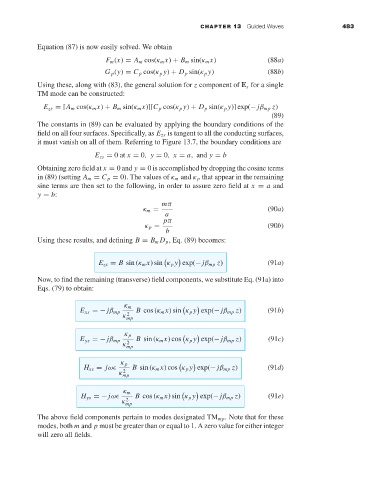Page 501 - Engineering Electromagnetics, 8th Edition
P. 501
CHAPTER 13 Guided Waves 483
Equation (87) is now easily solved. We obtain
F m (x) = A m cos(κ m x) + B m sin(κ m x) (88a)
G p (y) = C p cos(κ p y) + D p sin(κ p y) (88b)
Using these, along with (83), the general solution for z component of E s for a single
TM mode can be constructed:
E zs = [A m cos(κ m x) + B m sin(κ m x)][C p cos(κ p y) + D p sin(κ p y)] exp(− jβ mp z)
(89)
The constants in (89) can be evaluated by applying the boundary conditions of the
field on all four surfaces. Specifically, as E zs is tangent to all the conducting surfaces,
it must vanish on all of them. Referring to Figure 13.7, the boundary conditions are
E zs = 0at x = 0, y = 0, x = a, and y = b
Obtaining zero field at x = 0 and y = 0is accomplished by dropping the cosine terms
in (89) (setting A m = C p = 0). The values of κ m and κ p that appear in the remaining
sine terms are then set to the following, in order to assure zero field at x = a and
y = b:
mπ
κ m = (90a)
a
pπ
κ p = (90b)
b
Using these results, and defining B = B m D p , Eq. (89) becomes:
E zs = B sin (κ m x) sin κ p y exp(− jβ mp z) (91a)
Now, to find the remaining (transverse) field components, we substitute Eq. (91a) into
Eqs. (79) to obtain:
κ m
E xs =− jβ mp 2 B cos (κ m x) sin κ p y exp(− jβ mp z) (91b)
κ mp
κ p
E ys =− jβ mp B sin (κ m x) cos κ p y exp(− jβ mp z) (91c)
2
κ mp
κ p
H xs = jω B sin (κ m x) cos κ p y exp(− jβ mp z) (91d)
2
κ mp
κ m
H ys =− jω B cos (κ m x) sin κ p y exp(− jβ mp z) (91e)
2
κ mp
The above field components pertain to modes designated TM mp . Note that for these
modes, both m and p must be greater than or equal to 1. A zero value for either integer
will zero all fields.

